.jpg)
9 Best Internal Newsletter Software Tools for 2025


Is your company’s internal newsletter actually reaching employees—or getting lost in a sea of unread emails?
Internal communication has never been more critical. With hybrid work, frontline employees, and digital overload, keeping everyone informed is a challenge. That’s where internal newsletter software comes in. The right tool ensures employees stay engaged, updated, and connected—without adding to their inbox fatigue.
But not all platforms are built the same. Some prioritize beautifully designed emails, while others focus on automation, analytics, or mobile-friendly communication. Which one fits your organization best?
In this blog, we’ll break down the 10 best internal newsletter software tools for 2025—comparing their strengths, weaknesses, and best use cases. Whether you need AI-powered personalization, SMS-based messaging, or seamless integrations, this list will help you find the perfect fit.
Let’s explore the top solutions that can transform the way your company communicates.
Top 9 Internal Newsletter Software Tools for 2025
Effective internal communication is vital for organizational success. Utilizing internal newsletter software can significantly enhance employee engagement and streamline information dissemination. Here are the top 10 internal newsletter software tools for 2025:
1. Udext
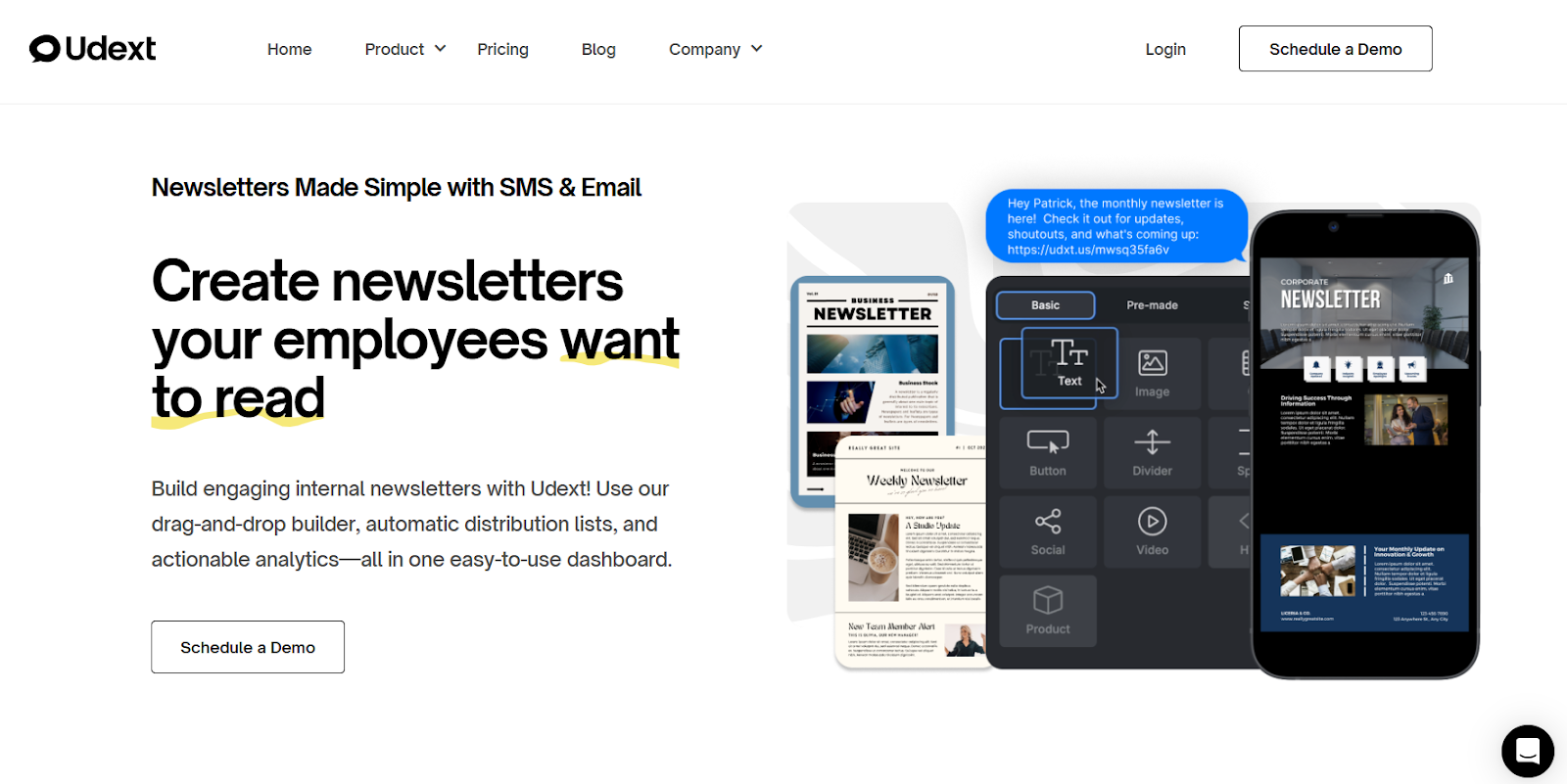
Udext is a powerful internal communication platform that enables organizations to engage their workforce through SMS and email newsletters. Recognizing that employees may not always have immediate access to email or company intranets, Udext leverages text messaging to ensure timely and effective communication. Its user-friendly interface allows companies to create professional, on-brand newsletters effortlessly using a drag-and-drop editor with access to over 100 customizable templates—no coding required.
Feature Highlights:
- Mass Text Messaging: Broadcast messages to all employees or specific groups with ease, ensuring that critical information reaches the intended audience promptly.
- Two-Way Communication: Facilitate dialogues between management and staff, allowing for immediate feedback and queries, which enhances engagement and responsiveness.
- Automation: Schedule messages and set up automated responses to streamline communication workflows, reducing manual effort and increasing efficiency.
- Advanced Analytics: Gain valuable insights with detailed analytics on open rates, click-throughs, read times, and more, empowering data-driven decisions to improve communication strategies.
- Dynamic Content & Segmentation: Customize newsletter content based on employee roles, departments, or locations to increase relevance and engagement.
- Multi-Channel Distribution: Easily distribute newsletters across multiple channels, including SMS and email, ensuring messages reach employees wherever they are, enhancing engagement and accessibility.
- HRIS and Payroll Integrations: Seamlessly sync all employee data with 200+ HRIS and payroll systems, ensuring accurate and updated information is always at your fingertips.
Pros:
- High Open Rates: SMS boasts over 90% open rates compared to email’s 20%, ensuring your content gets read and engages your employees effectively.
- Instant Reach: SMS delivers messages directly to employees' mobile devices, making it ideal for urgent updates and time-sensitive information.
- No App Download Required: Employees receive communications without needing to install additional applications, reducing barriers to engagement and ensuring accessibility for all staff members.
Cons:
- Primarily Focused on SMS and Email: While Udext excels in SMS and email communications, it may lack support for other communication channels, which could limit versatility for organizations seeking a more integrated communication platform.
- Limited Multimedia Support via SMS: Due to SMS constraints, richer content like images or videos cannot be included directly in text messages, which may affect the richness of the communication.
Best For:
Companies with a significant number of frontline workers or mobile teams that require immediate and reliable communication without relying on email or app-based platforms.
See How It Works>> to keep your teams connected.
2. ContactMonkey
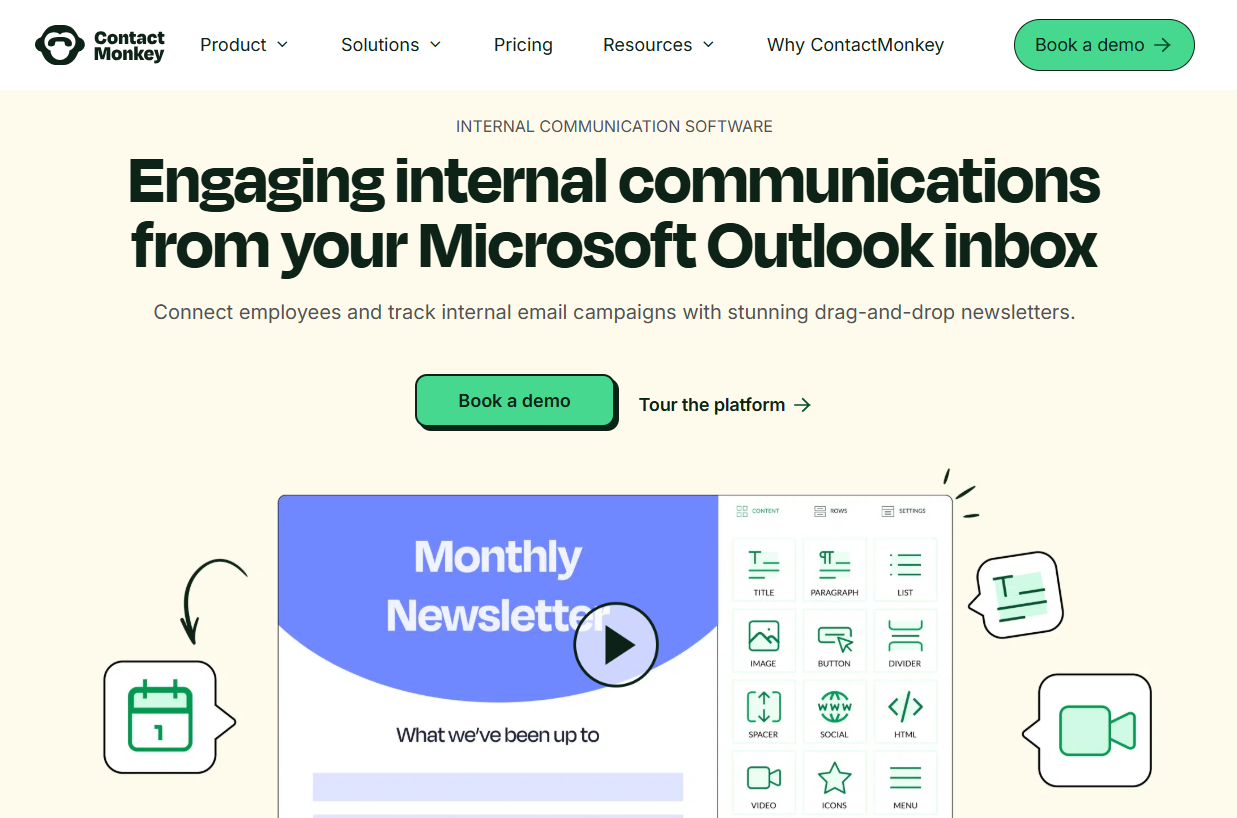
ContactMonkey is an internal email communication platform that integrates seamlessly with Outlook and Gmail. It empowers organizations to create, send, and track engaging internal newsletters directly from their existing email infrastructure. By eliminating the need for external platforms, ContactMonkey simplifies the communication process and enhances employee engagement through personalized and interactive content.
Key Features:
- Drag-and-Drop Email Builder: Design visually appealing newsletters without any coding knowledge.
- Real-Time Analytics: Track open rates, click-through rates, and employee engagement metrics to measure the effectiveness of communications.
- Employee Surveys: Embed surveys, polls, and feedback forms directly within emails to gather insights from staff.
- Dynamic Content: Personalize messaging for different audience segments within a single email send.
Pros:
- Seamless Integration: Works within familiar email clients, reducing the learning curve and encouraging adoption.
- Enhanced Engagement: Interactive elements like surveys and polls foster greater employee participation.
- Detailed Insights: Comprehensive analytics enable data-driven decisions to improve internal communications.
Cons:
- Email-Centric: Focuses primarily on email communications, lacking SMS or mobile app support.
- Potential Email Overload: Without careful management, there's a risk of overwhelming employees with too many emails.
Best For:
Mid to large enterprises utilizing Microsoft 365 or Google Workspace that seek to enhance their internal email communications with interactive and measurable content.
3. Staffbase
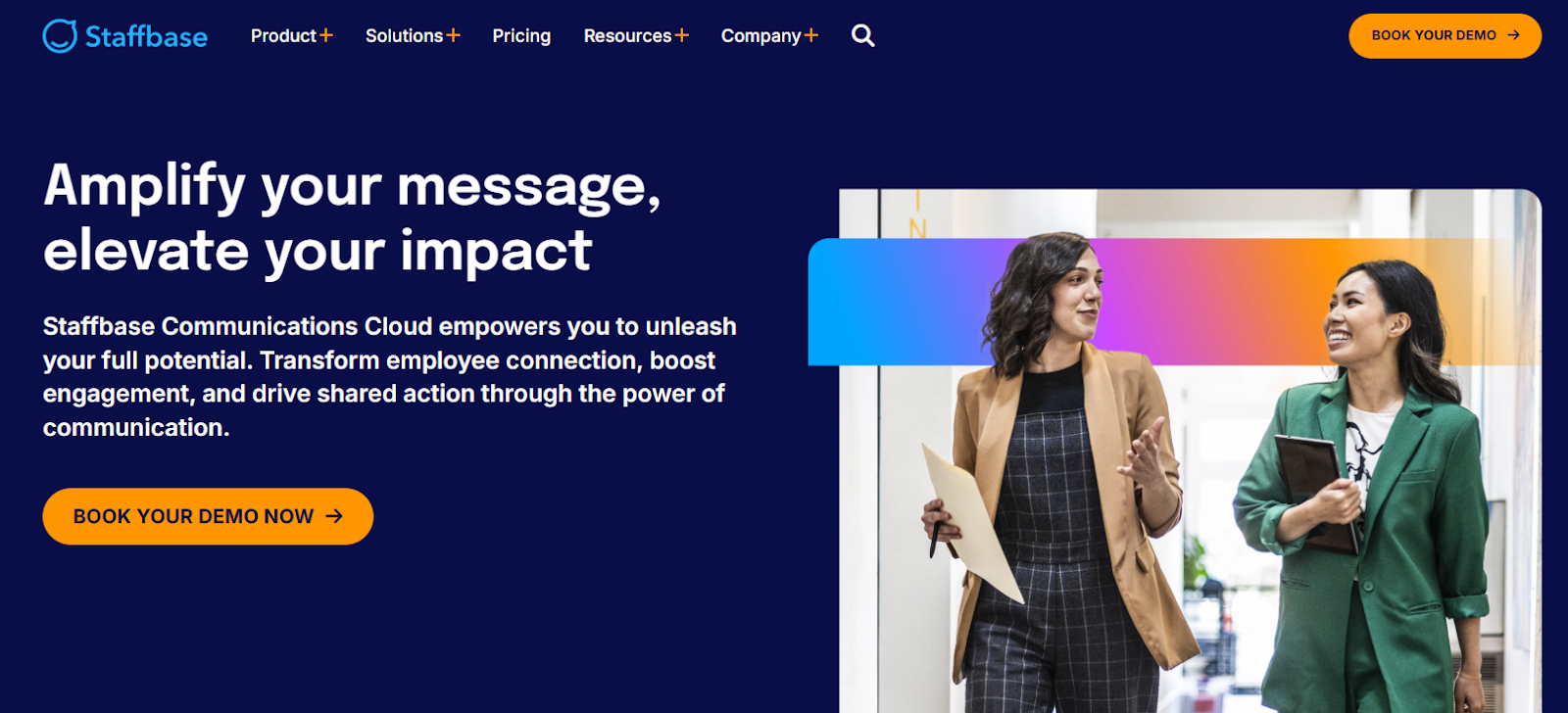
Staffbase offers one of the best internal communication tools that includes robust newsletter capabilities. Designed to centralize and streamline employee communications, Staffbase provides tools for creating engaging newsletters, managing content distribution, and measuring engagement across various channels. Its focus on personalization and accessibility ensures that employees receive relevant information in a timely manner.
Key Features:
- Email Builder: Craft and send newsletters with customizable templates and a user-friendly interface.
- Intranet Integration: Combine newsletters with intranet content to provide a unified communication experience.
- Mobile App Support: Reach employees on their mobile devices through a dedicated app, enhancing accessibility.
- Advanced Analytics: Gain insights into open rates, click-through rates, and employee engagement to refine communication strategies.
Pros:
- All-in-One Platform: Integrates various communication channels, reducing the need for multiple tools.
- High Customization: Offers extensive options to tailor communications to different employee segments.
- Mobile Accessibility: Ensures that deskless and remote workers stay informed through mobile support.
Cons:
- Complexity: The breadth of features may be overwhelming for smaller businesses with limited resources.
- Implementation Time: Comprehensive setup and customization can require a significant time investment.
Best For:
Enterprises seeking a complete internal communication suite that integrates newsletters, intranet content, and mobile accessibility to engage a diverse and distributed workforce.
4. Cerkl Broadcast
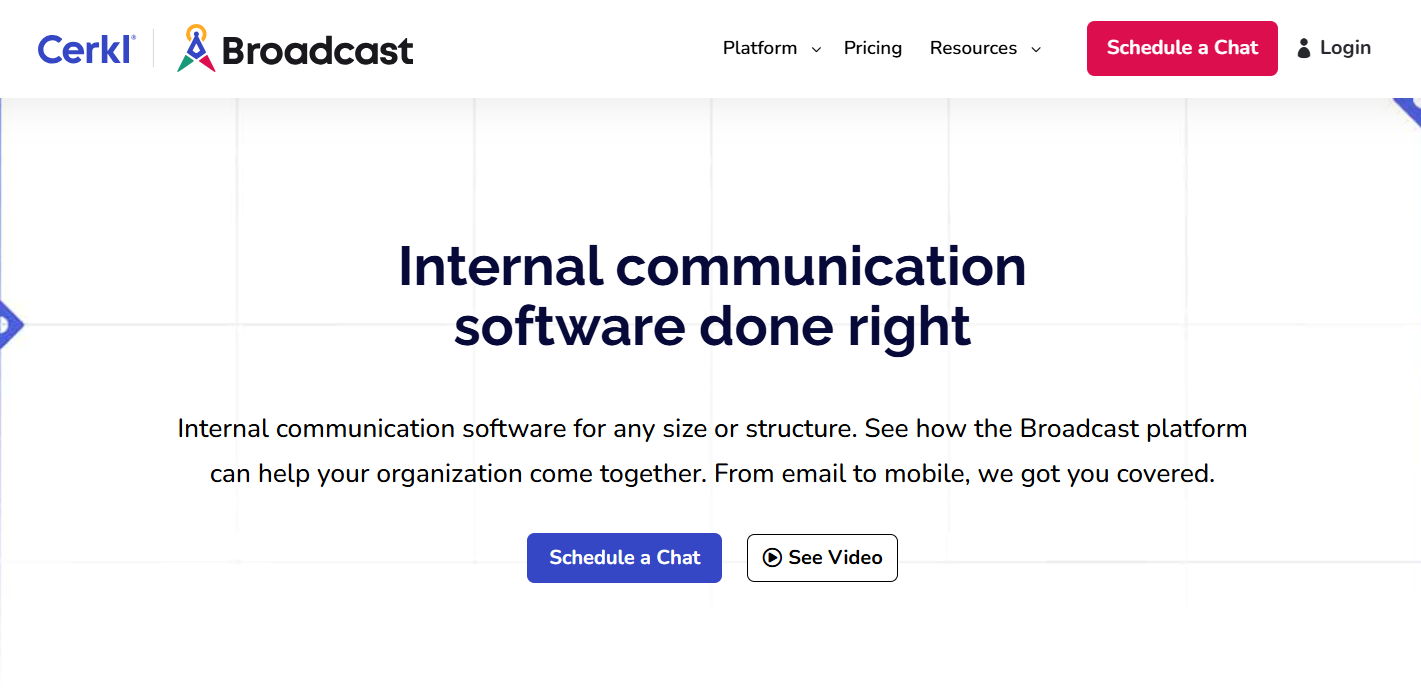
Cerkl Broadcast is an internal communication platform designed to enhance employee engagement through personalized content delivery. It automates the creation and distribution of internal newsletters, ensuring each employee receives relevant information tailored to their preferences. This personalization aims to increase open rates and overall engagement within organizations.
Key Features:
- Automated News Digests: Delivers weekly personalized newsletters to employees, reducing the manual effort in content curation.
- Audience Segmentation: Allows targeting specific employee groups based on various criteria, enhancing message relevance.
- Real-Time Analytics: Provides insights into open rates, click-through rates, and trending content, aiding in the assessment of communication effectiveness.
- Omni-Channel Communication: Supports content distribution across multiple channels, including email, mobile apps, and integrations with platforms like Slack and SharePoint.
Pros:
- Time-Saving Automation: Reduces the workload associated with manual newsletter creation through AI-driven content curation.
- Enhanced Personalization: Delivers content tailored to individual employee interests, potentially boosting engagement rates.
- Comprehensive Analytics: Offers detailed metrics to evaluate and improve communication strategies.
Cons:
- Implementation Complexity: Setting up and customizing the platform may require a significant time investment and technical resources.
- Learning Curve: Users may need time to become proficient with the platform's extensive features.
Best For:
Organizations seeking to automate their internal newsletter processes with personalized content delivery and aiming to enhance employee engagement through targeted communications.
5. Workshop
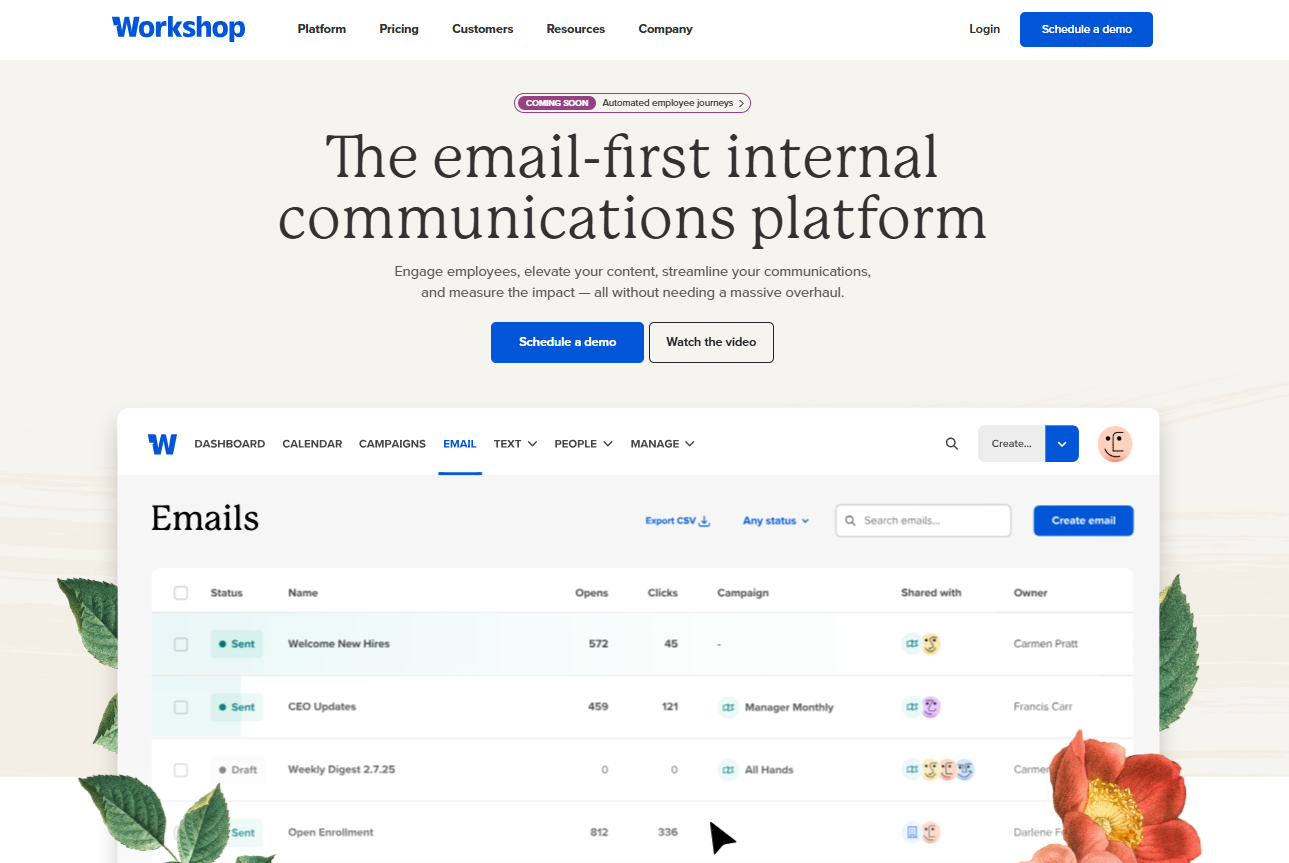
Workshop is an internal newsletter software designed to simplify the creation and distribution of engaging employee communications. It offers a user-friendly interface with drag-and-drop templates, enabling teams to craft newsletters quickly without technical expertise. The platform integrates with existing HR systems to maintain up-to-date distribution lists, ensuring accurate targeting.
Key Features:
- Intuitive Email Editor: Provides customizable templates and a drag-and-drop interface for easy newsletter creation.
- Automated List Management: Syncs with HR systems to automatically update distribution lists based on employee data.
- Detailed Analytics: Tracks metrics such as open rates, click-through rates, and engagement by department or location.
- Multi-Channel Distribution: Supports sharing newsletters via email, Slack, SharePoint, and other platforms.
Pros:
- Ease of Use: Designed for non-technical users, allowing quick creation and distribution of newsletters.
- Accurate Targeting: Automated list management ensures communications reach the intended audience.
- Comprehensive Metrics: Provides insights to assess the effectiveness of internal communications.
Cons:
- Limited Advanced Features: May lack some of the more sophisticated functionalities found in other internal communication platforms.
- Customization Constraints: While templates are available, there may be limitations in design flexibility.
Best For:
Small to mid-sized companies seeking an easy-to-use internal newsletter solution that integrates with existing systems and provides essential analytics.
6. Poppulo
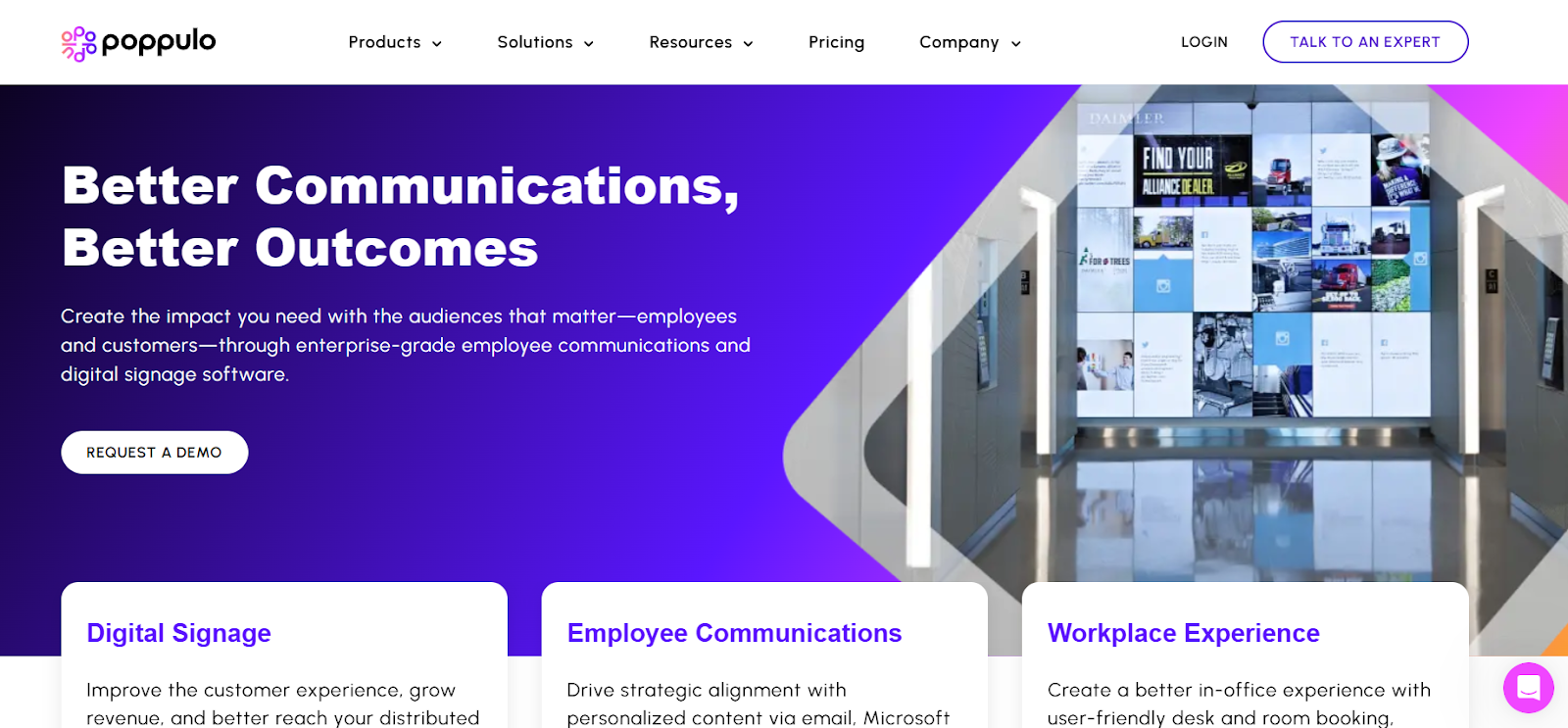
Poppulo is an internal communications platform that specializes in creating, distributing, and analyzing employee newsletters. It focuses on delivering personalized content to employees, aiming to improve engagement and alignment with company objectives. The platform is designed to centralize email communications for large, globally dispersed teams, enhancing consistency and ease of management.
Key Features:
- Advanced Personalization: Tailors content to individual employees based on their roles, locations, and preferences.
- Intuitive Drag-and-Drop Editor: Enables the creation of branded newsletters without requiring coding skills.
- Robust Analytics: Offers detailed reporting on email performance, including open rates and engagement metrics.
- Scalability: Designed to handle communications for large enterprises with a global workforce.
Pros:
- Enhanced Engagement: Personalized content delivery can lead to higher employee engagement rates.
- User-Friendly Interface: Simplifies the newsletter creation process, making it accessible to users with varying technical skills.
- Comprehensive Reporting: Provides insights to measure and improve the effectiveness of internal communications.
Cons:
- Resource Intensive Implementation: Deploying the platform across a large organization may require significant time and resources.
- Cost Considerations: The comprehensive features and scalability may come with a higher price point, which could be a factor for smaller organizations.
Best For:
Large enterprises seeking a scalable internal newsletter solution that offers advanced personalization and detailed analytics to enhance employee communication strategies.
7. BeePro
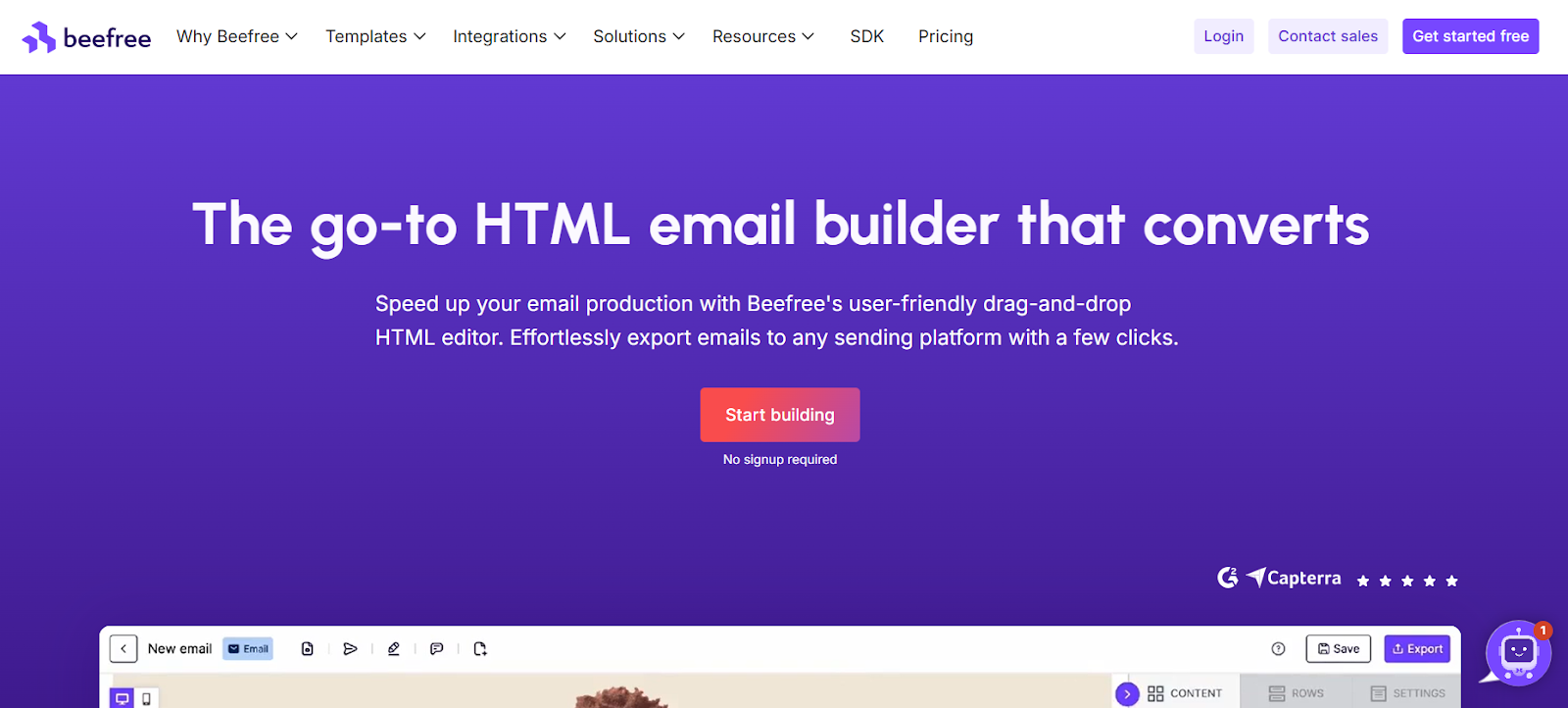
BeePro is a drag-and-drop email design tool that helps businesses create visually appealing internal newsletters. It allows users to design newsletters without coding, making it accessible to teams of all skill levels. The platform supports responsive email templates, ensuring optimal display across devices. With its collaboration features, multiple team members can work on newsletters simultaneously, improving efficiency.
Key Features:
- Drag-and-Drop Editor: Easily design newsletters with customizable templates and content blocks.
- Mobile Optimization: Ensures newsletters look professional on all devices.
- Collaboration Tools: Multiple users can edit and review newsletters in real time.
- Integration Options: Connects with email platforms like Mailchimp, HubSpot, and Gmail.
Pros:
- User-friendly interface with pre-built templates.
- Allows real-time collaboration for content creation.
- Supports multiple export options to various email platforms.
Cons:
- Lacks built-in email distribution or analytics.
- Limited automation capabilities compared to other internal newsletter software.
Best For:
Organizations that prioritize professional email design and need an intuitive tool for creating visually engaging internal newsletters.
8. Fliplet
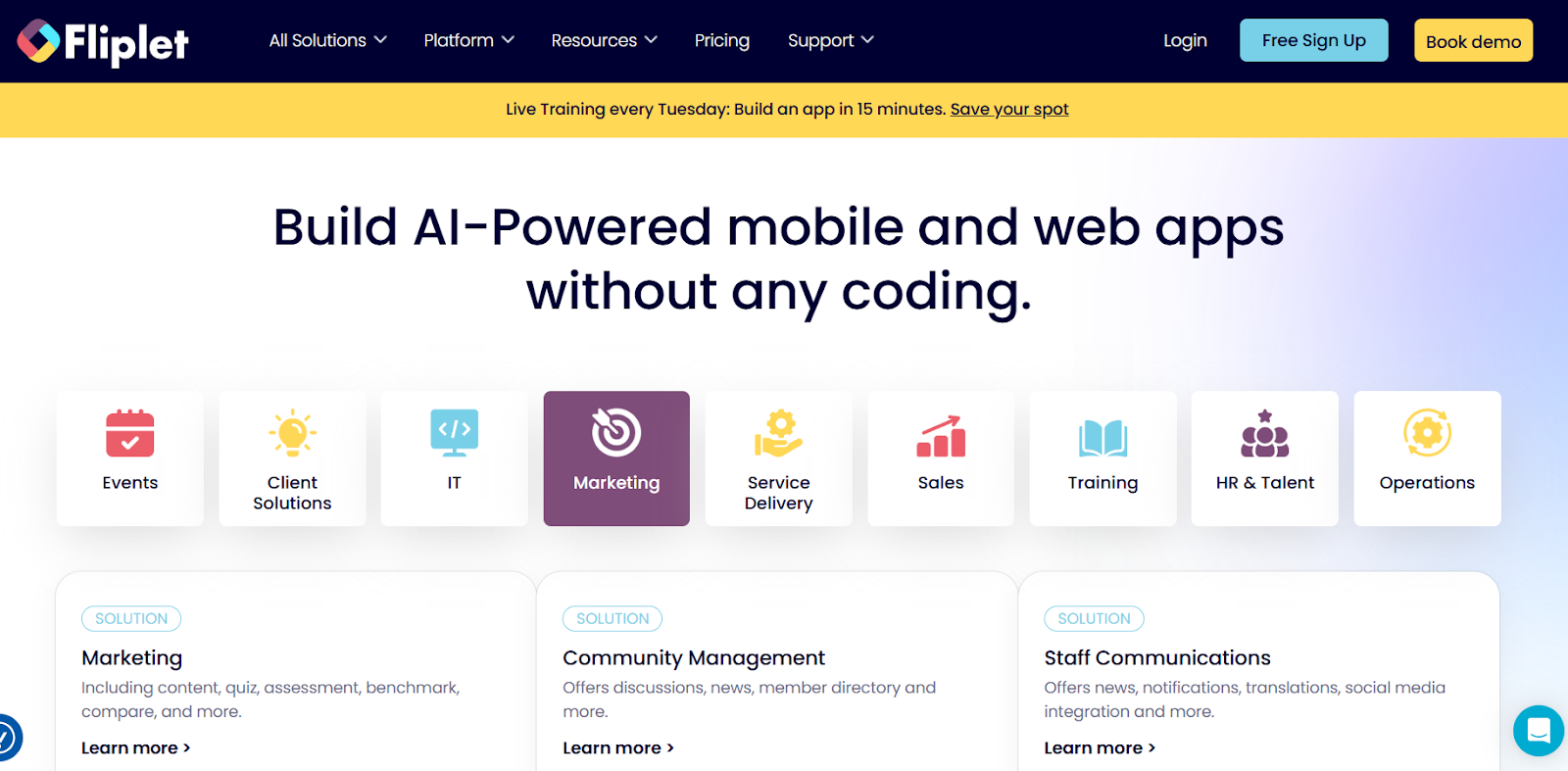
Fliplet is a no-code platform that helps businesses create custom apps, including internal newsletter applications. It offers a range of templates that allow companies to design and distribute digital newsletters via mobile apps, web apps, and emails. The platform enhances employee communication by making newsletters interactive, incorporating videos, surveys, and other multimedia elements.
Key Features:
- No-Code App Builder: Create internal newsletter apps without technical expertise.
- Multimedia Integration: Supports videos, surveys, and interactive content.
- Multi-Platform Access: Newsletters can be accessed via web, mobile, or email.
- User Analytics: Tracks engagement metrics to measure content performance.
Pros:
- Enables the creation of interactive newsletters.
- No coding required for customization.
- Works across multiple platforms for wider accessibility.
Cons:
- Learning curve for teams unfamiliar with app-based newsletters.
- May be more complex than traditional email newsletter solutions.
Best For:
Companies looking for an interactive, mobile-friendly alternative to traditional email newsletters.
9. FirstUp
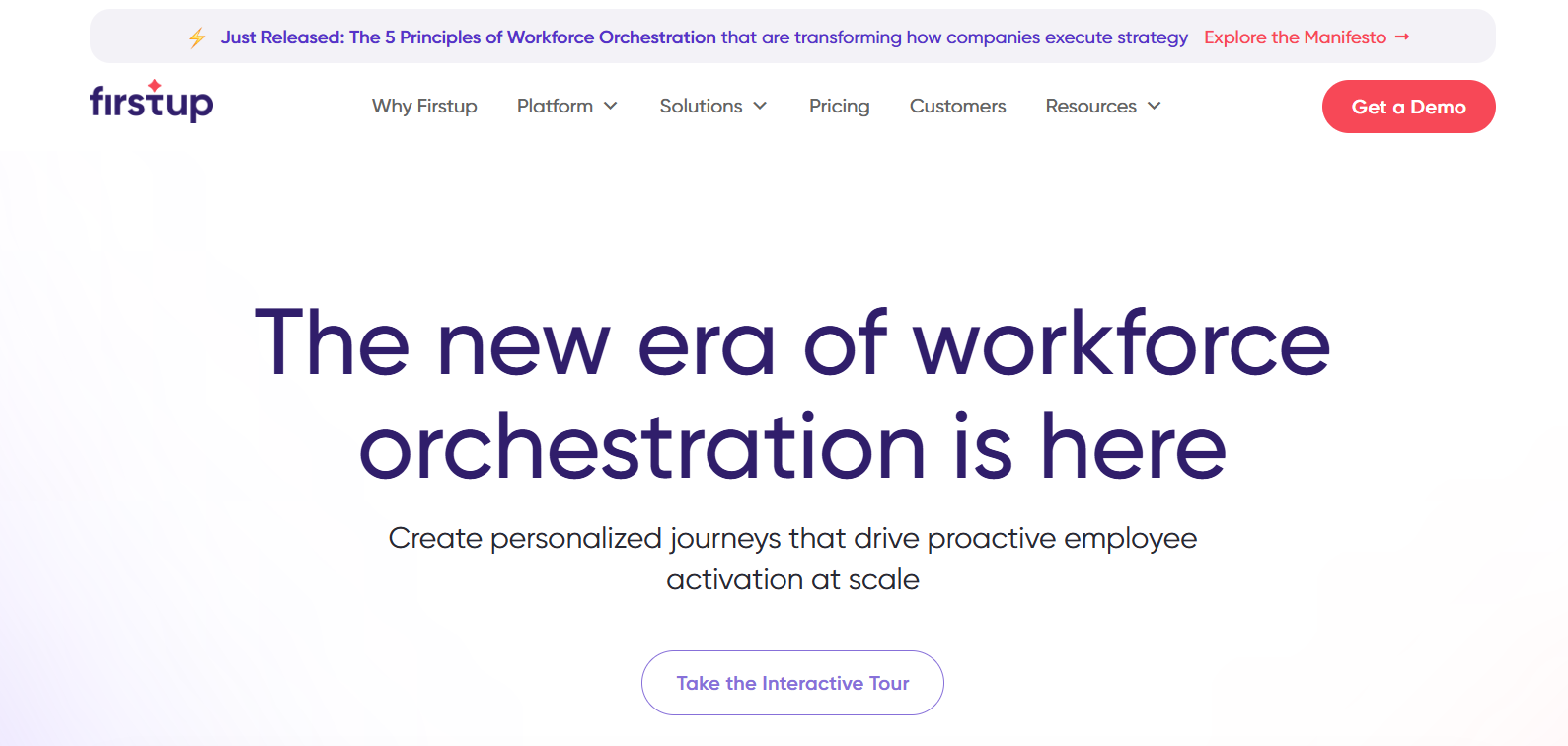
Firstup is an AI-powered internal communication platform designed to engage employees through personalized content. It allows businesses to send newsletters through multiple channels, including email, mobile, and enterprise apps. AI-driven insights help optimize content for better engagement.
Key Features:
- AI-Powered Personalization: Delivers tailored content to employees based on behavior and preferences.
- Omni-Channel Distribution: Sends newsletters via email, mobile, Slack, and Microsoft Teams.
- Real-Time Analytics: Tracks open rates, engagement trends, and content effectiveness.
- Automation Tools: Schedules and automates newsletter distribution.
Pros:
- Delivers personalized content for higher engagement.
- Supports communication across multiple platforms.
- Provides detailed insights for performance improvement.
Cons:
- Setup requires time and configuration.
- AI-driven features may require fine-tuning for accuracy.
Best For:
Large organizations seeking an AI-driven internal newsletter software to enhance employee engagement and communication.
Selecting the right internal newsletter software depends on your business needs. In the next section, let’s look at the important criteria to consider when choosing the right platform.
Criteria for Selecting the Best Internal Newsletter Software
Choosing the right internal newsletter software is essential for keeping employees informed and engaged. The best tools simplify content creation, improve communication, and offer insights into employee engagement. Here’s what you should consider before making a decision.
Ease of Use
The best internal newsletter software should have an intuitive interface that requires minimal training. A drag-and-drop editor, pre-built templates, and simple customization options help teams create newsletters quickly. Employees across departments, including HR, internal communications, and IT, should find it easy to use.
Customization & Personalization
Every company has unique branding and communication needs. The software should allow you to customize templates, incorporate logos, and match corporate colors. Personalization features like audience segmentation, content targeting, and dynamic fields improve engagement by delivering relevant information to employees based on location, role, or department.
Integration Capabilities
Seamless integration with existing tools is crucial. Look for software that connects with HRIS systems, Microsoft Teams, Slack, and email platforms. Integrations ensure newsletters reach employees where they already communicate. For companies using intranet solutions, compatibility with internal portals enhances accessibility.
Analytics & Reporting
Tracking newsletter performance helps improve content strategy. The software should provide insights into open rates, click-through rates, and engagement levels. Advanced analytics tools help measure content effectiveness and identify trends in employee interaction. Some platforms even offer A/B testing to refine messaging based on real data.
Mobile Accessibility
A mobile-friendly internal newsletter is essential for remote and non-desk employees. The software should support responsive designs, ensuring content is easy to read on any device. Mobile app integration is an added advantage for companies with frontline workers who rely on their smartphones for internal communication.
Automation & AI Features
Automation simplifies newsletter scheduling, follow-ups, and audience segmentation. AI-powered features can help optimize send times, suggest content based on engagement trends, and even generate subject lines to boost open rates. Smart scheduling ensures newsletters reach employees at the right time without manual effort.
Cost & Scalability
Pricing should align with your company’s size and needs. Look for software with flexible plans that accommodate growing teams. Some tools charge per user, while others offer flat-rate pricing. Ensure the platform can scale as your workforce expands without requiring a costly upgrade.
The right internal newsletter software enhances communication, increases employee engagement, and provides data-driven insights. By prioritizing ease of use, personalization, integration, and analytics, you can choose a tool that meets your organization’s needs.
Conclusion
Choosing the right internal newsletter software is essential for keeping employees engaged and informed. Whether your team prefers email-based newsletters, AI-powered personalization, or mobile-friendly solutions, the best tool depends on your company’s size, goals, and communication needs. Features like automation, analytics, and integration with workplace tools can improve how information flows across your organization.
If you’re looking for a direct and effective way to reach employees, Udext provides a powerful alternative with SMS-based internal communication. Unlike traditional email newsletters, Udext ensures instant message delivery, higher open rates, and direct engagement—without requiring employees to check their inboxes. Its mass messaging, two-way communication, and automation features make it ideal for companies with frontline workers or mobile teams.
Want to improve your internal communication strategy? Book a demo today and see how SMS-based newsletters can keep your workforce connected—wherever they are.
{{see-udext="https://www.udext.com/symbols"}}
Need to improve your internal comms? Take a look at Udext!
"Out of the box, Udext has everything you need to elevate your internal communication. It’s incredibly easy to set up and use, with a straightforward interface and great customer support"
John D.
Director of HR at Apex Manufacturing


.svg)



.jpg)

